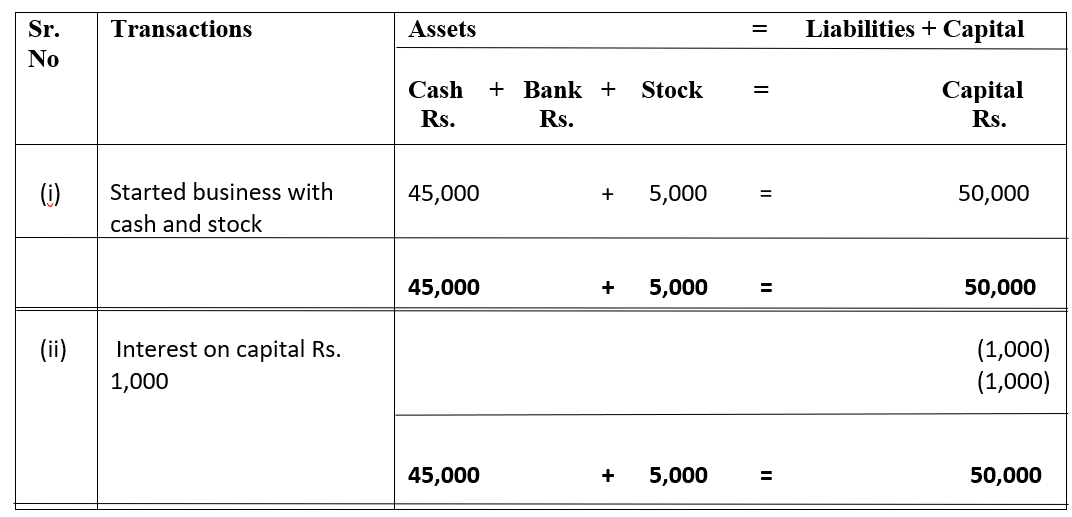Interest on drawings Drawings refer to the money withdrawn by owners/partners for personal use from the business. The drawings, in accounting terms, can be of any type. It can be cash withdrawn from business or furniture or car etc. Drawings are money or assets that are withdrawn from a company by iRead more
Interest on drawings
Drawings refer to the money withdrawn by owners/partners for personal use from the business. The drawings, in accounting terms, can be of any type. It can be cash withdrawn from business or furniture or car etc. Drawings are money or assets that are withdrawn from a company by its owners for personal use and must be recorded as a reduction of assets. It’s paid back to the business with some interest.
Interest on drawings is an income for the business and reduces the capital of the owner. Interest on drawings is the amount of interest paid by the partners, calculated concerning the period for which the money was withdrawn.
- It’s an income for the business. Hence, credited to P&L Appropriation A/c.
- It’s an expense for the owner/partner. Therefore, debited to owner’s/partner’s capital a/c
- Interest on drawings is charged to the partners only when there is an agreement made among the partners in this regard or if it is mentioned in the Partnership Deed.
Formulae for Interest on drawings
There are three formulae used for calculating the interest on drawings. They are:
1. Simple Method: In this method, as the name suggests, the amount of interest on drawings is calculated simply for the time the amount has been utilized.
Interest on Drawings = Amount of drawings × Rate/100 × No. of Months/12
2. Product Method: This method is used when-
- Drawings are made of unequal amounts at irregular intervals of time. Then this formula is used-
Interest on Drawings = Total of Products × Rate/100 × 1/12
- When drawings are made of equal amounts at regular/equal intervals of time. Then interest on drawings can be calculated on the total of the amount drawn, for the average of the period applicable to the first and last installment.
Interest on Drawings= Total amount of drawings × Rate/ 100 × Average Period/12
Also, note-
Average Period = (No. of months left after first drawings+ No. of months left after last drawings)/2
Example:
Harish withdrew equal amounts at the beginning of every month for 9 months. Total drawings amounted to ₹6,000. Calculate the interest on drawings charged if the rate was 6% p.a.
Solution:
Average period = (No. of months left after first drawings+ No. of months left after last drawings)/2 = (9+1)/2 = 5 months
Interest on Drawings = Total of drawings × Rate/100 × 5/12
Journal entry for interest on drawings:

Interest transferred to Profit & Loss A/c:

See less




Sundry Debtors Sundry Debtors are those persons or firms to whom goods have been sold or services rendered on credit and the payment has not been received from them. In other words, Debtors are the persons or firms from whom the payment is to be received by the business. For Example, Ramen Sold goodRead more
Sundry Debtors
Sundry Debtors are those persons or firms to whom goods have been sold or services rendered on credit and the payment has not been received from them. In other words, Debtors are the persons or firms from whom the payment is to be received by the business.
For Example, Ramen Sold goods to Sam on credit, Sam did not pay for the goods immediately, so here Sam is the debtor for Ramen because he owes the amount to Ramen.
Another Example, If goods worth Rs 7000 have been sold to Sid on credit, he will continue to remain as debtor of the business so long as he does not make the full payment.
Treatment:
Sundry Debtor is considered as a current asset and hence it is shown on the assets side of the balance sheet under the Current Assets heading.
Sundry Debtors are not considered as an item of profit and loss because it is not considered as an item of income or expense. However, the items associated with sundry debtors such as bad debts or provision for doubtful debts or bad debts recovered are shown in profit and loss accounts in the debit and credit sides respectively.
Sundry Creditors
Sundry creditors are those persons or firms from whom goods have been purchased or services rendered on credit and for which payment has not been made. In other words, Creditors are the person or firms to whom some money has to be paid by the business.
For Example, Ramen purchased goods from Sam on credit, Ramen did not pay for the goods immediately, so here Ramen is the creditor for Sam because he owes money to Sam.
Another Example, If Mr. Johnson purchased goods worth Rs 3000 from M/s. Rick & Co. on credit, Mr. Johnson will continue to remain as a creditor of M/s. Rick & Co. as long as the full payment is made by Mr. Johnson.
Treatment:
Sundry Creditor is shown in the liabilities side of the balance sheet under the heading Current Liabilities.
See less